The numbers behind new lockdowns: Covid hospitalisations could reach levels seen in the first wave by OCTOBER, experts warn as ONS estimates England’s outbreak has DOUBLED in a week
- Office for National Statistics estimates of daily new cases has risen from 3,200 to 6,000 in the past week
- The body estimates there are a total of 59,800 people infected in England at a time, up from 39,700
- Official testing data and numbers of people in hospital are rising, too, prompting second wave fears
- Health Secretary has warned rising hospital admissions mean it is ‘critical’ for people to follow rules
- Current trends suggest there could be more than 1,000 people going into hospital per day by October
Rising hospitalisations among people with coronavirus could mean admissions hit levels not seen since April next month, current trends show as Matt Hancock warned patient numbers are doubling every eight days.
Another 4,322 people have been diagnosed with Covid-19, the Government announced today in the highest one-day rise since May 8, as a raft of worrying statistics revealed the Covid-19 crisis appears to be rebounding.
Data from the Office for National Statistics suggests 6,000 people are catching the life-threatening illness every day in England while hospital admissions have doubled in a week and government scientists warn the R rate could now be as high as 1.4.
The Health Secretary has warned another blanket national lockdown was the ‘last line of defence’ but said now is a ‘big moment for the country’.
Government data shows 183 newly-infected Covid-19 patients were admitted to hospitals in England on Wednesday, compared to just 84 eight days ago and just 38 on August 30. It means 160 patients are needing NHS care each day, on average — triple the figure of 52 on September 1.
More than 3,000 people each day were being admitted to NHS hospitals during the peak of the first wave in April. Analysis suggests, at the current trend, it would take little more than three weeks for daily admissions to top the 2,000 mark. But experts insist a second wave of Covid-19 in Britain would not be nearly as fatal as the first because doctors have got better at treating the disease, thanks to scientific breakthroughs.
The ONS report suggests swab-testing is picking up around half of all infections, with an average of 3,300 people currently testing positive for Covid-19 each day. It is considered the most accurate data of its kind and falls in line with figures from a separate symptom-tracking app, which estimates cases have also doubled in a week to 7,500.
SAGE today revealed the R rate of the virus in the UK could be as high as 1.4 – the highest estimate since the group began making them. Outbreaks are also growing in all regions and expanding by up to eight or nine per cent per day in some places, Number 10’s advisory board also warned.
Health officials today also announced 27 more coronavirus deaths in the UK’s official count, with 14 in NHS hospitals in England.
Scientists said the numbers, which they noted are rising across the board, were ‘undoubtedly concerning’ but ‘not surprising’. Although the Government fears a second wave is coming, case, hospital and death rates are still significantly below where they were during the depths of the crisis and many scientists agree that Britain is unlikely to find itself in the same situation again.
It comes as another swathe of England is being ordered into coronavirus lockdown as Mr Hancock today admitted that a new national Covid squeeze is on the cards and Professor Chris Whitty, the chief medical officer for England, is reported to be pushing the Prime Minister to consider it.
New curbs in some regions include a curfew on pubs and restaurants and a ban on socialising outside of households, and will be introduced across parts of the North West, Midlands and West Yorkshire from Tuesday.
And health bosses revealed the first of the mothballed NHS Nightingale hospitals has been told to be ready to be reopened within just 48 hours. The temporary site in Birmingham’s NEC arena – officially opened by Prince William via videolink in April – has been placed on ‘higher alert’ footing.
In other coronavirus developments today:
- London mayor Sadiq Khan has cancelled the capital’s New Year celebrations and warned that the city is only two weeks behind areas of the country plunged into local lockdowns;
- The Northeast saw a busy night in bars after Matt Hancock confirmed the region would be hit by a 10pm curfew from tonight;
- Ministers have defended the shambolic testing system as thousands of people struggle to get checked for the disease, after Dido Harding claimed no-one expected the scale of demand as schools returned;
- Mr Hancock repeatedly ducked saying whether people should snitch on their neighbours for breaking the Rule of Six, after Boris Johnson and Priti Patel sent starkly different messages;
- Boris Johnson begs Brits to ‘save Christmas’ by obeying ‘Rule of Six’, warning lockdown will only get stricter.
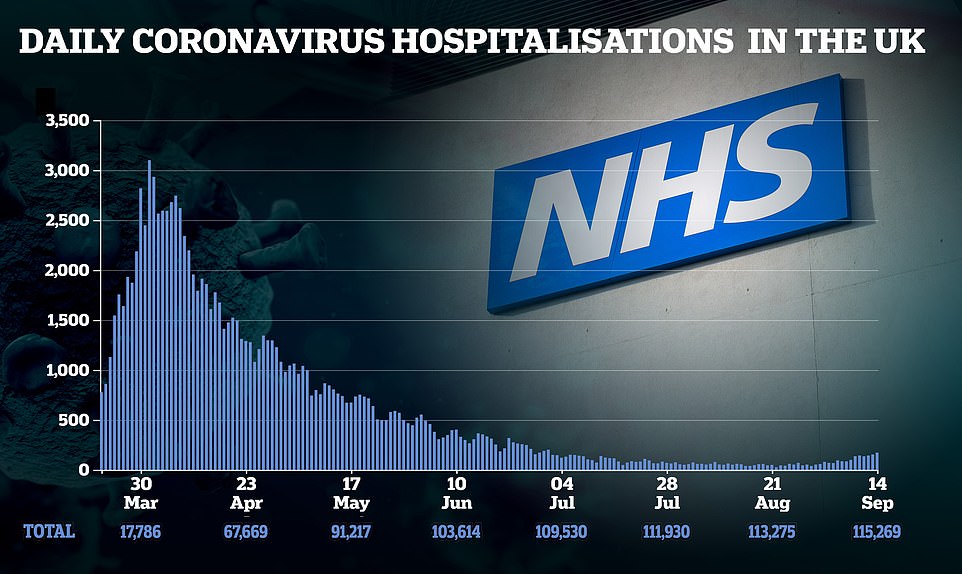
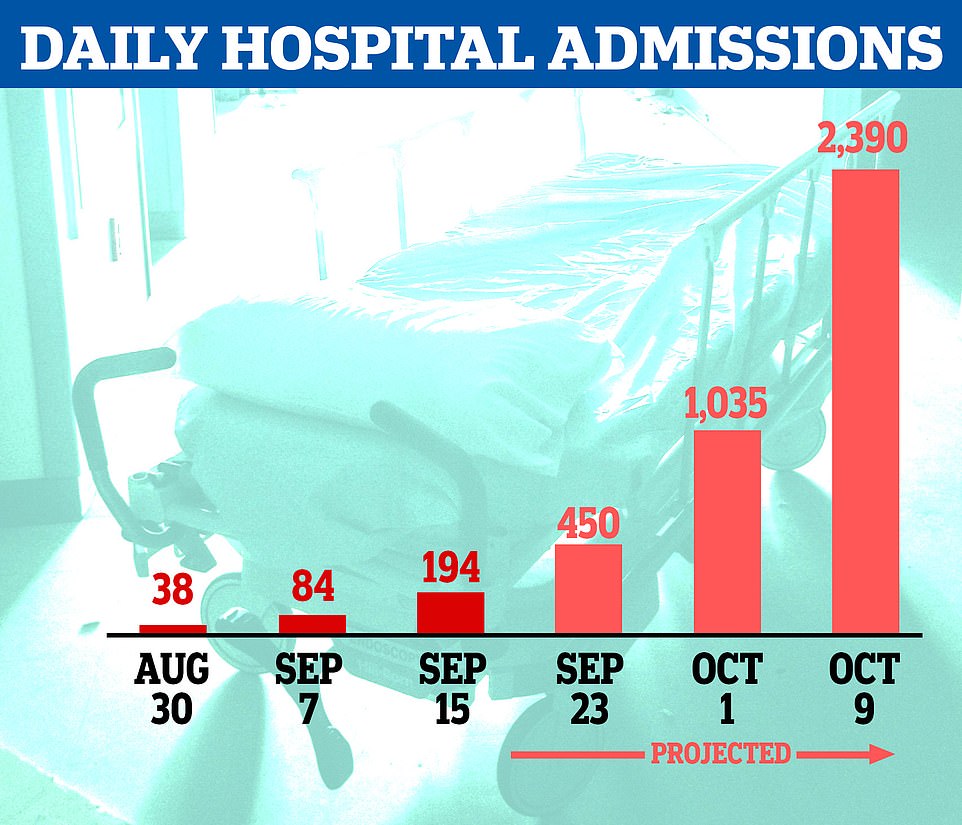
Analysis suggests, at the current trend, it would take little more than three weeks for daily admissions to top 2,000
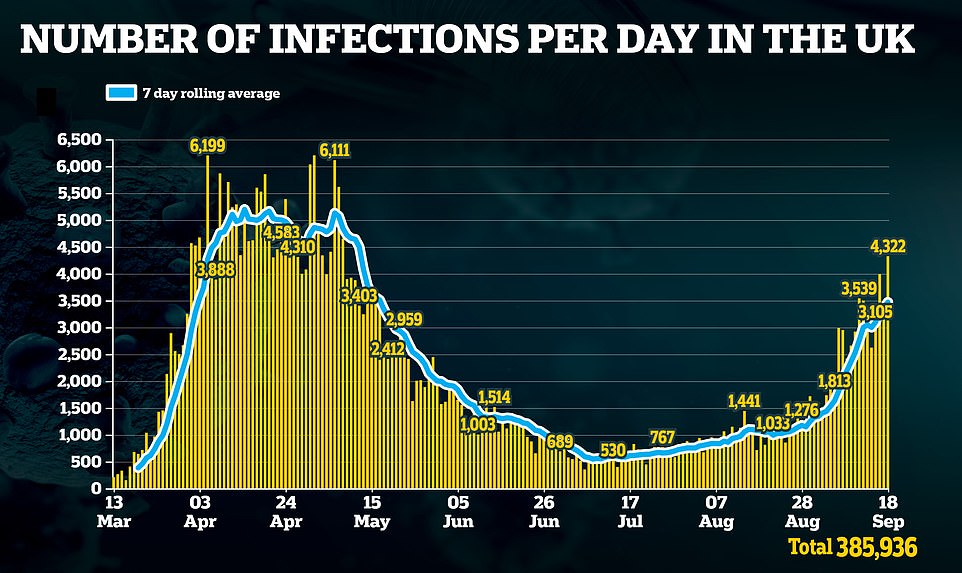
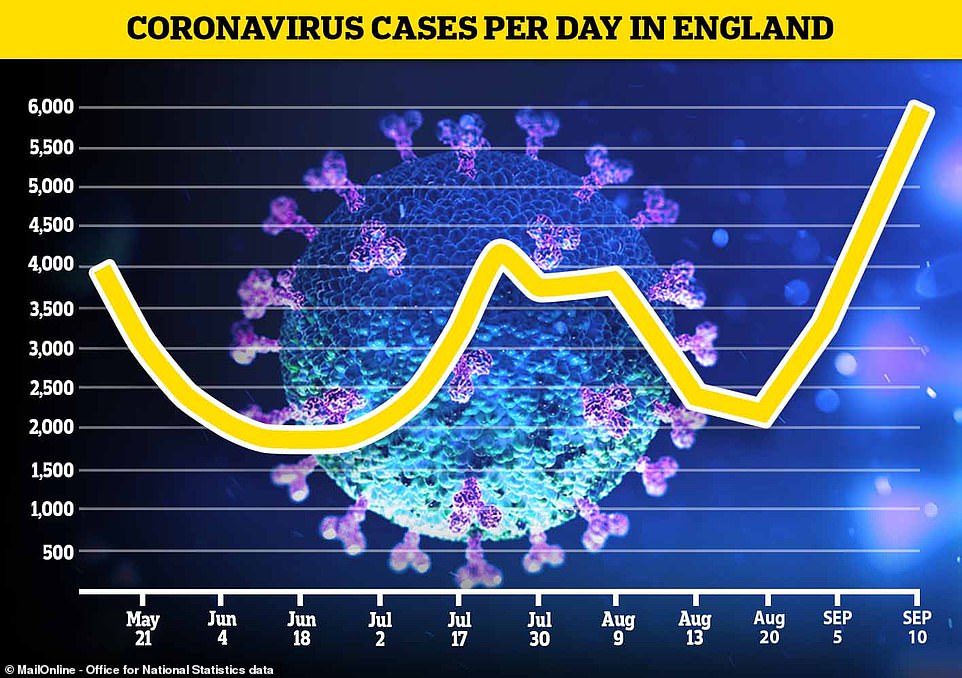
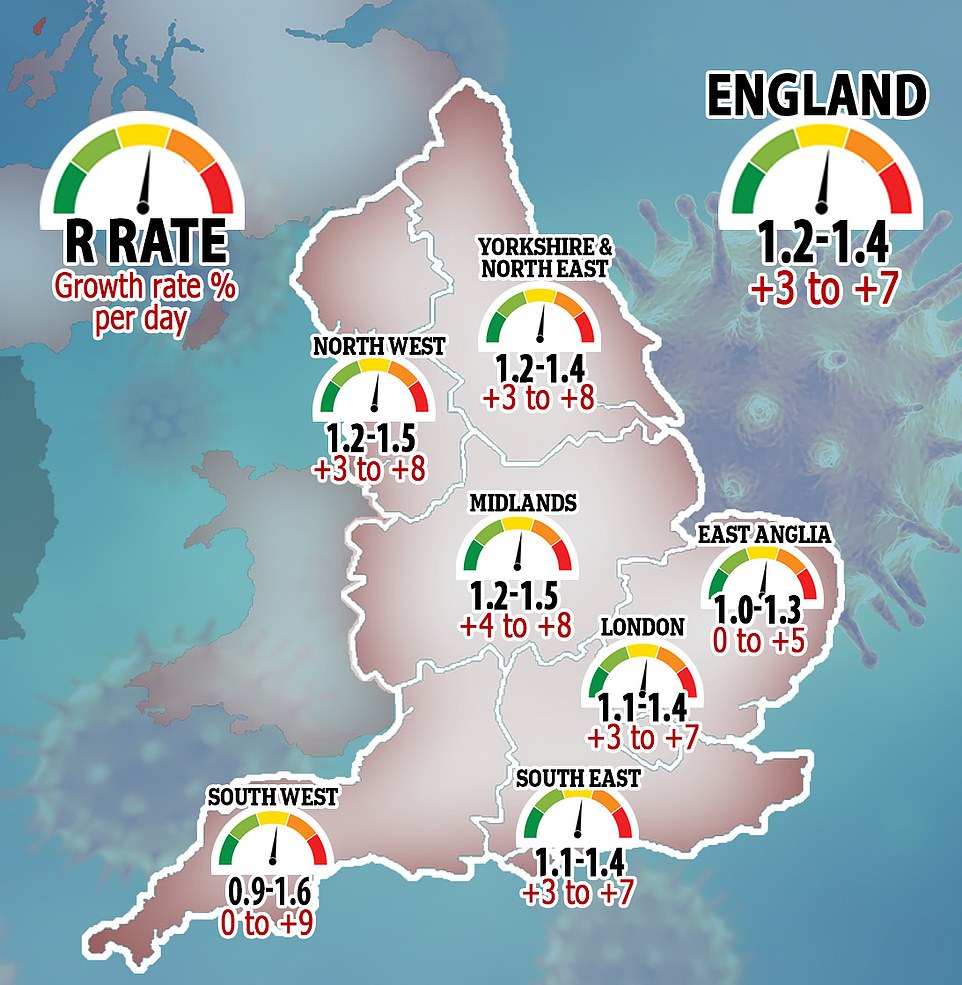
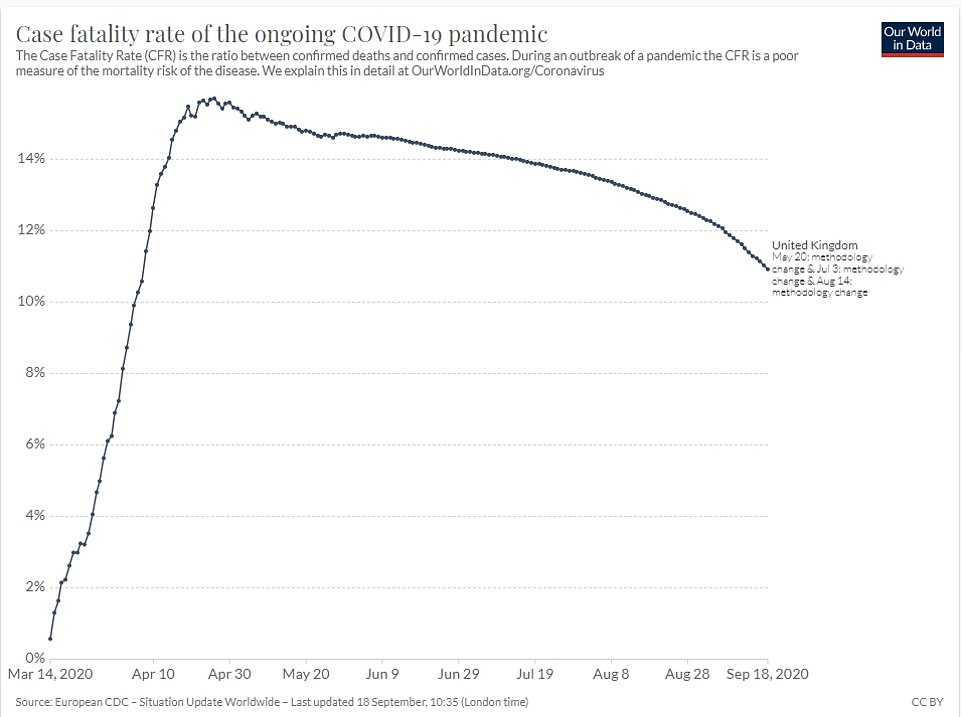
But experts insist a second wave of Covid-19 in Britain would not be nearly as fatal as the first because doctors have got better at treating the disease, thanks to scientific breakthroughs. Data shows how the case-fatality rate, the number of deaths for every confirmed case, has dropped since the start of the outbreak in Britain
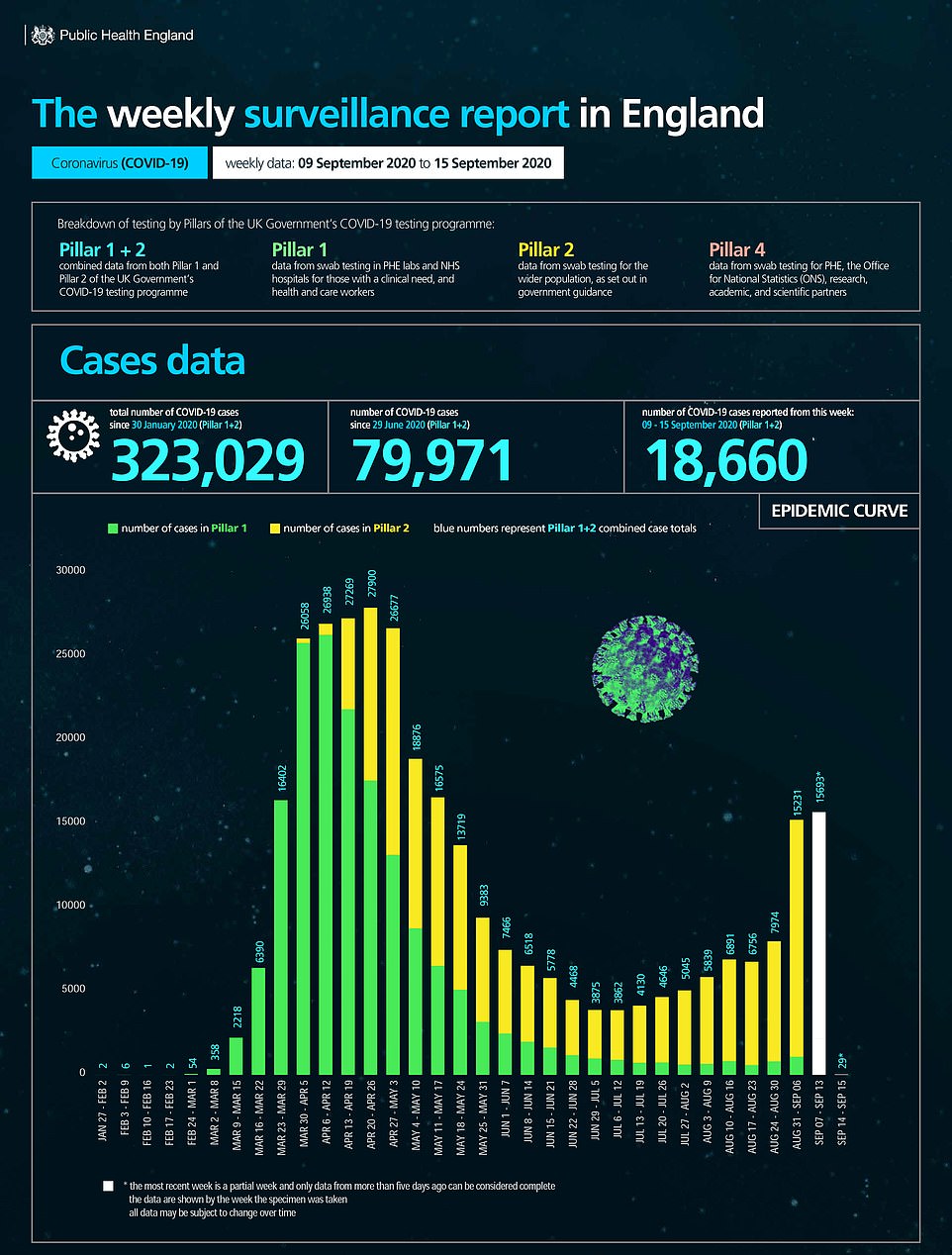
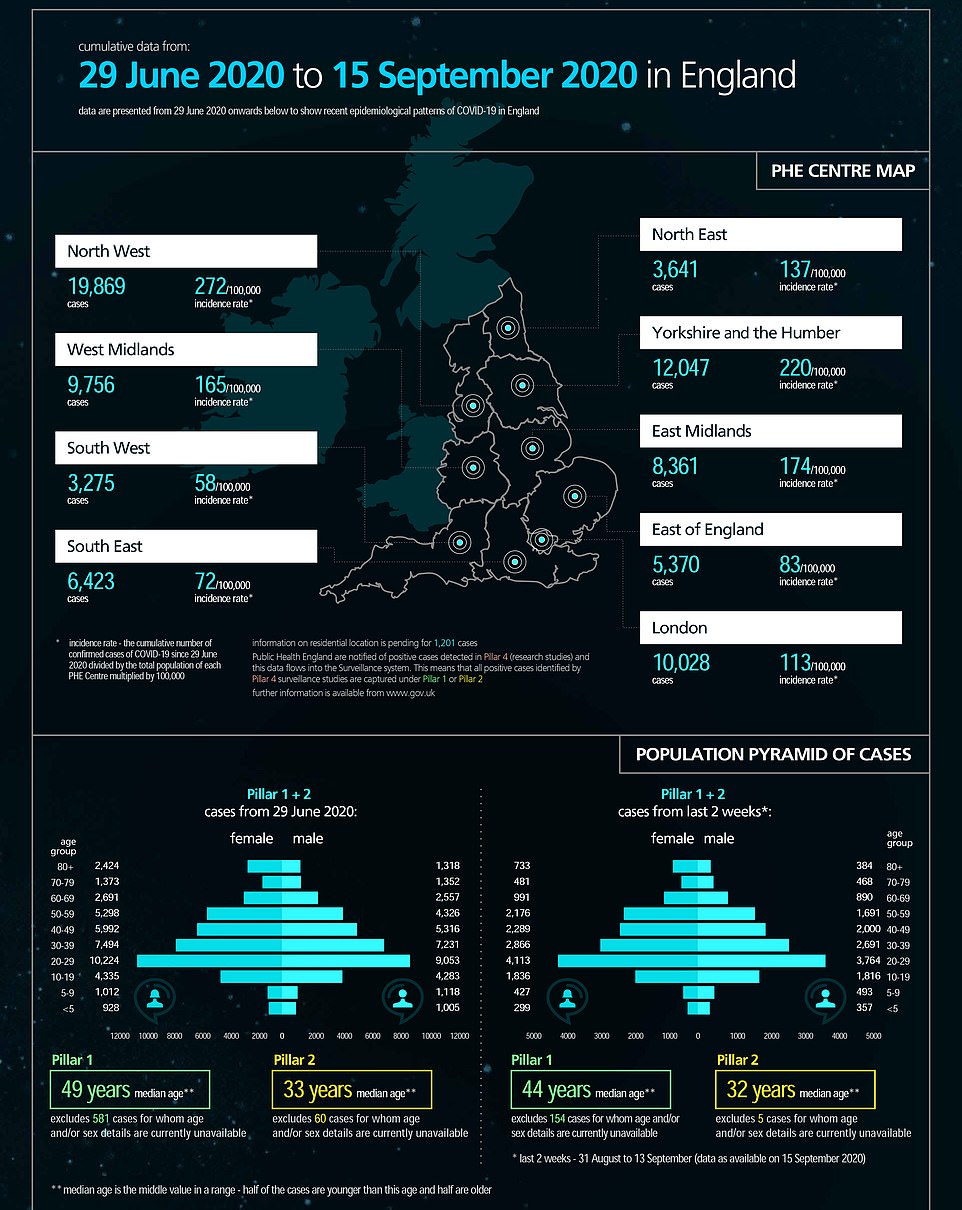
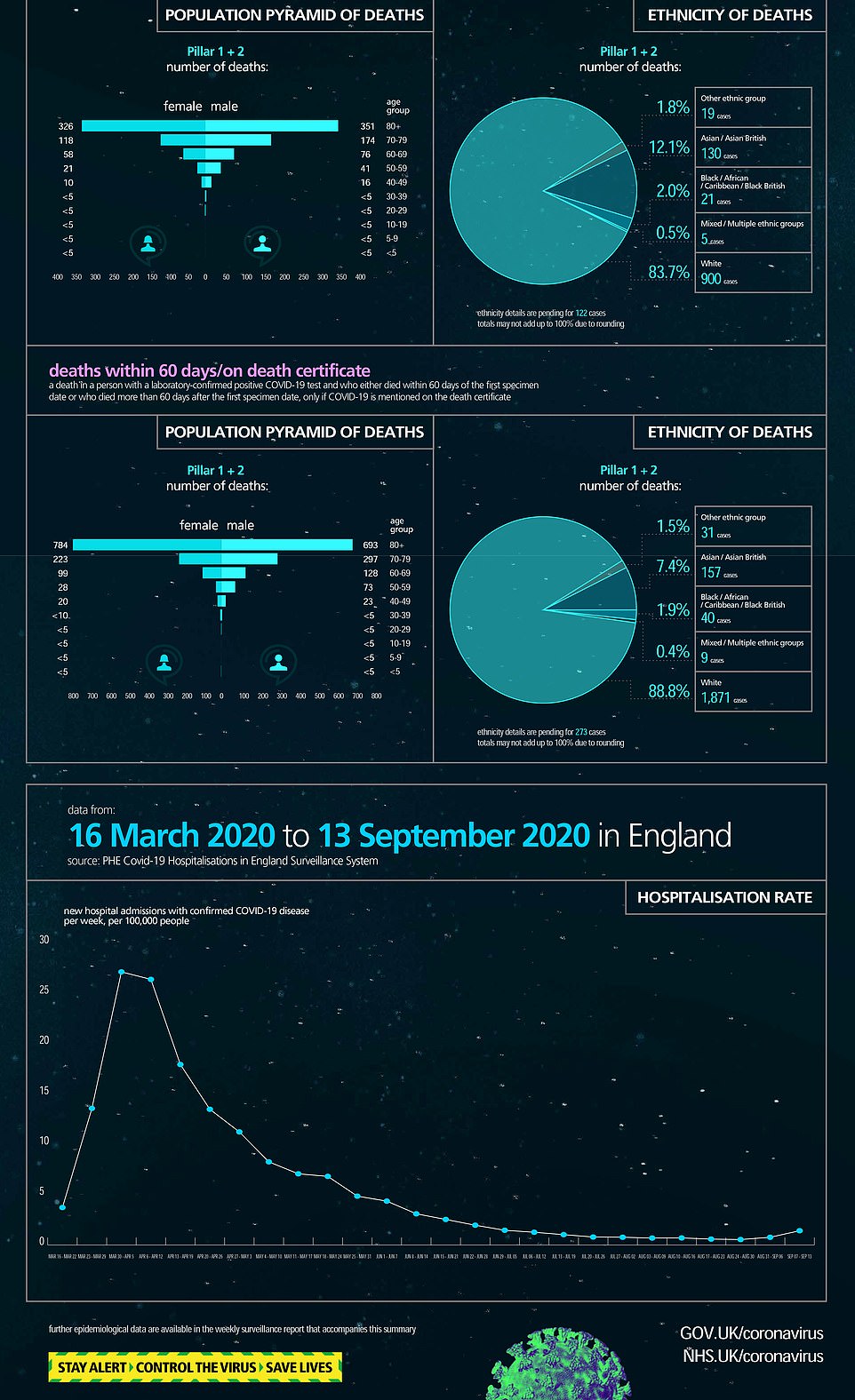
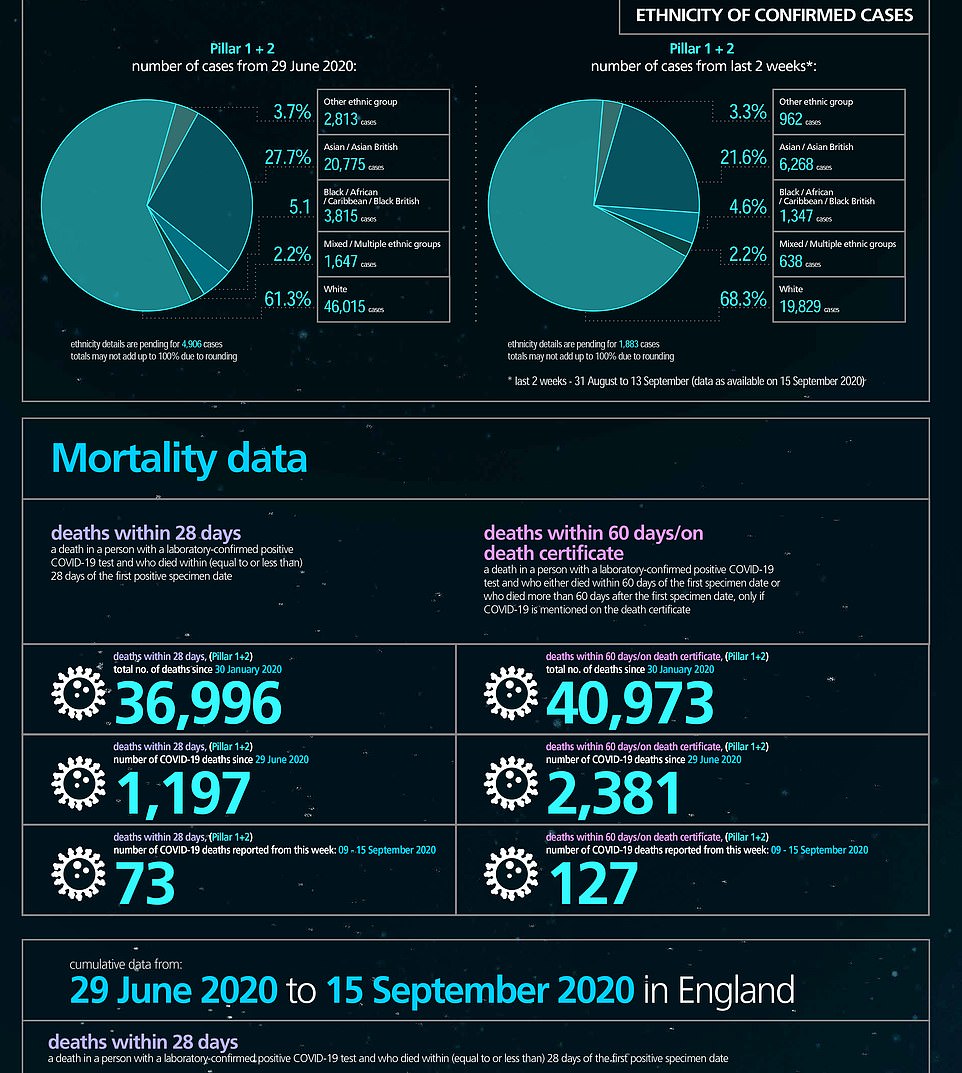
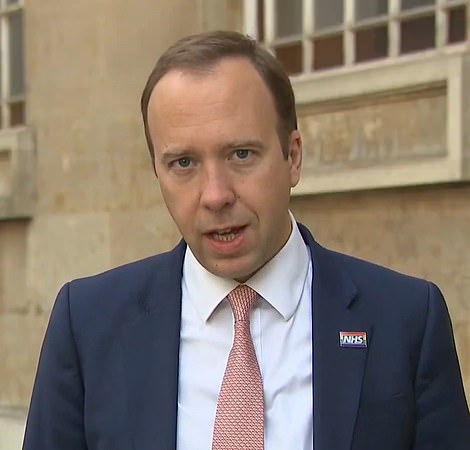
The Health Secretary pleaded with the public to ‘come together to tackle this virus’
Today’s ONS data comes as part of mass regular testing that has been done over the past six weeks, taking in 208,730 swab test results from the same people each week.
It showed that around 0.11 per cent of them were infected with the virus between September 3 and September 10, up from 0.07 per cent last week.
This equated to a total of 136 actual positive tests, showing around one in every 900 people is infected.
The report said London and the North West were the areas that appeared to have highest infection rates, while the virus was least widespread in the West Midlands and the South West.
London has escaped local lockdown rules since the national restrictions were lifted, despite bearing the brunt of the outbreak during the first wave.
But the ONS report shows that the capital now appears to have one of the highest infection rates in the country, with an estimated 0.2 per cent of people testing positive. This was second only to the North West, which was thought to have the same level of infection.
The stats confirmed that young people appear to be driving the surge in new cases.
‘In recent weeks,’ the report said, ‘there has been clear evidence of an increase in the number of people testing positive for Covid-19 aged 2 to 11 years, 17 to 24 years and 25 to 34 years.’
In addition to the ONS data, the weekly prediction from King’s College London, which runs a symptom-tracking app with healthcare tech company ZOE, suggests that 5,962 people in England are catching the virus each day, with another 1,600 in Scotland, Wales and Northern Ireland.
The King’s data is based on 8,000 tests done between August 31 and September 13 and found that infections appear to be highest in the North East and North West of England, which are both seeing an estimated 1,600 cases per day.
Professor Kevin McConway, a statistician at The Open University, said: ‘This is undoubtedly concerning, and particularly so when we take into account that the data behind these estimates come from several sources, many of which – such as hospital admissions, admissions to intensive care, and deaths – lag behind the growth in new infections, because it takes time for people to become ill enough to require hospital treatment or, sadly, to die.
‘So the estimates cannot take into account very recent changes in the patterns of new infections.’
Dr Simon Clarke, a microbiologist at the University of Reading, said: ‘These data show a significant increase in the number of infections, albeit possibly at a slower doubling-rate than had been reported previously.
‘This does not yet mean that the epidemic is uncontrollable and it may still be possible to hold it at bay with sufficient social distancing and hygiene, but that does require the public to engage properly.
‘There has been a lot of argument about the significance of the current uptick in infections, but this loses sight of the fact that in the spring, Covid-19 put a large numbers people into hospital, very quickly, hindering the ability of the NHS from delivering care to people in pain on waiting lists, cancer sufferers and denied pregnant women from having the support of their partners. That could easily happen again and academic hair-splitting makes no difference to people’s day-to-day lives.’
The Health Secretary has today pleaded with the public to ‘come together to tackle this virus’ and admitted that a new national crackdown could be on the cards because it ‘isn’t just cases’ that are increasing.
Professor Chris Whitty, England’s chief medical officer, is reportedly pushing for another lockdown to try and get the virus back under control.
According to former World Health Organization expert Anthony Costello, the PM has been told by Professor Whitty that such a move may be needed to stop the recent rise in infections.
He said: ‘I’m hearing from a well-connected person that government now thinks, in absence of testing, there are 38,000 infections per day. Chris Whitty is advising PM for a two week national lockdown.’
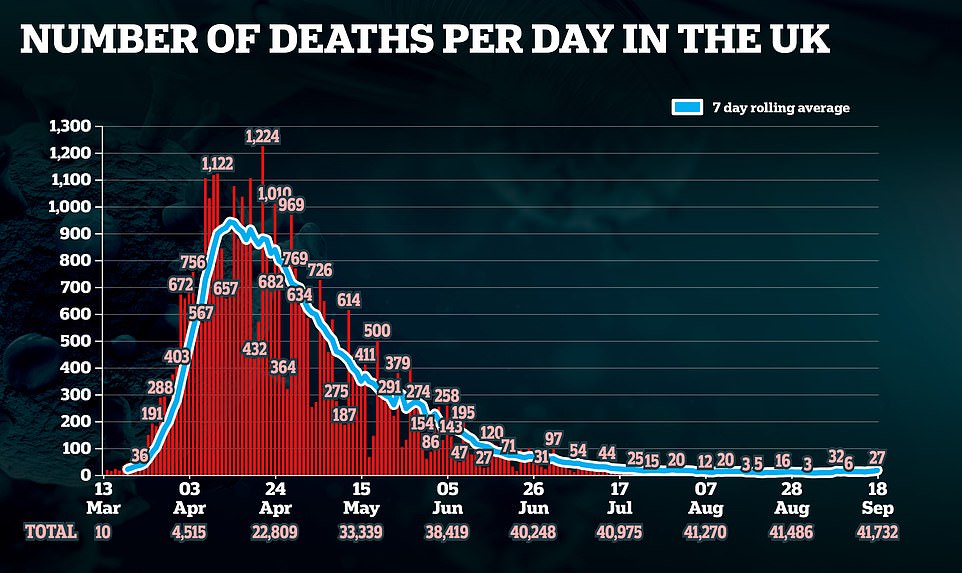
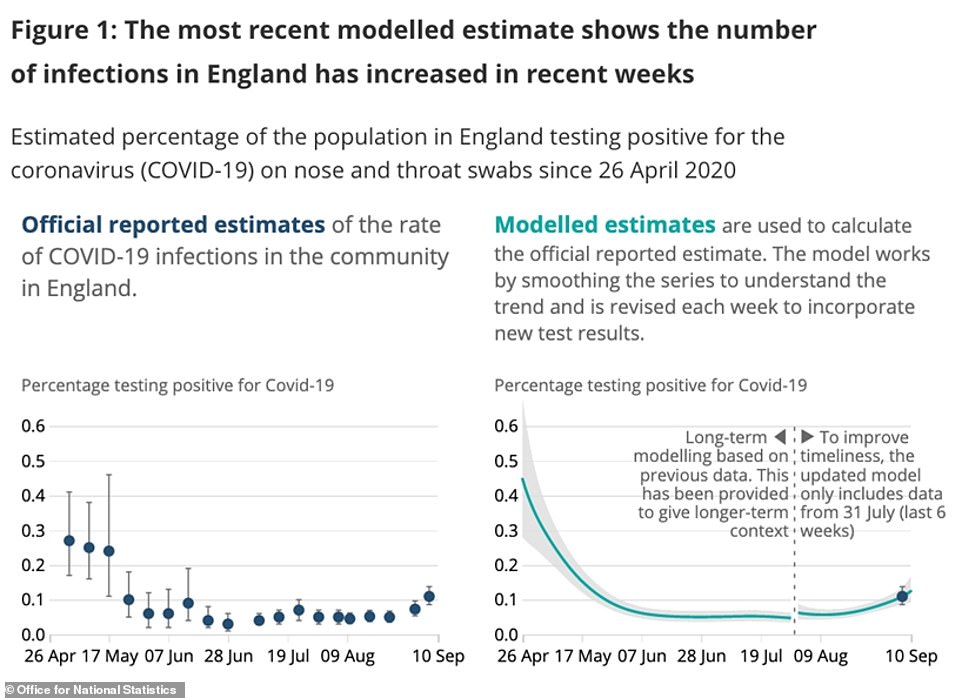
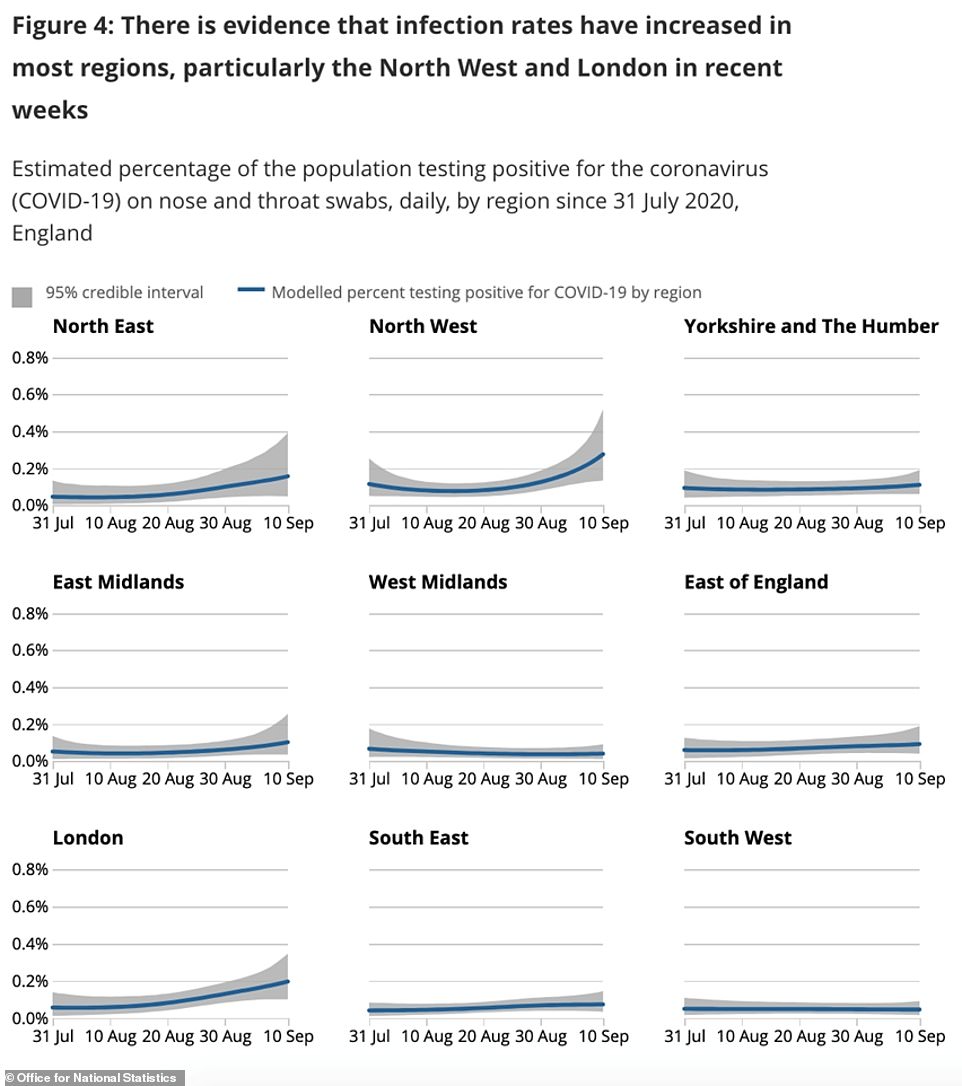
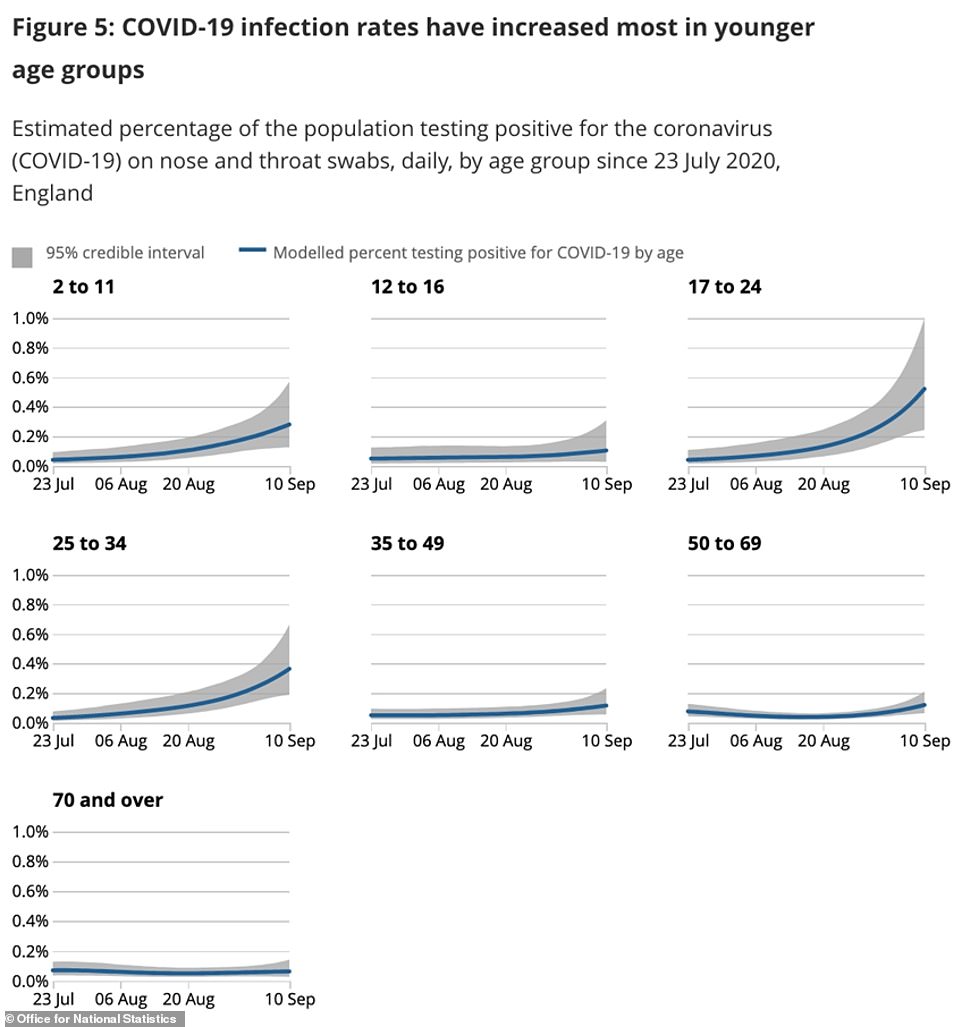
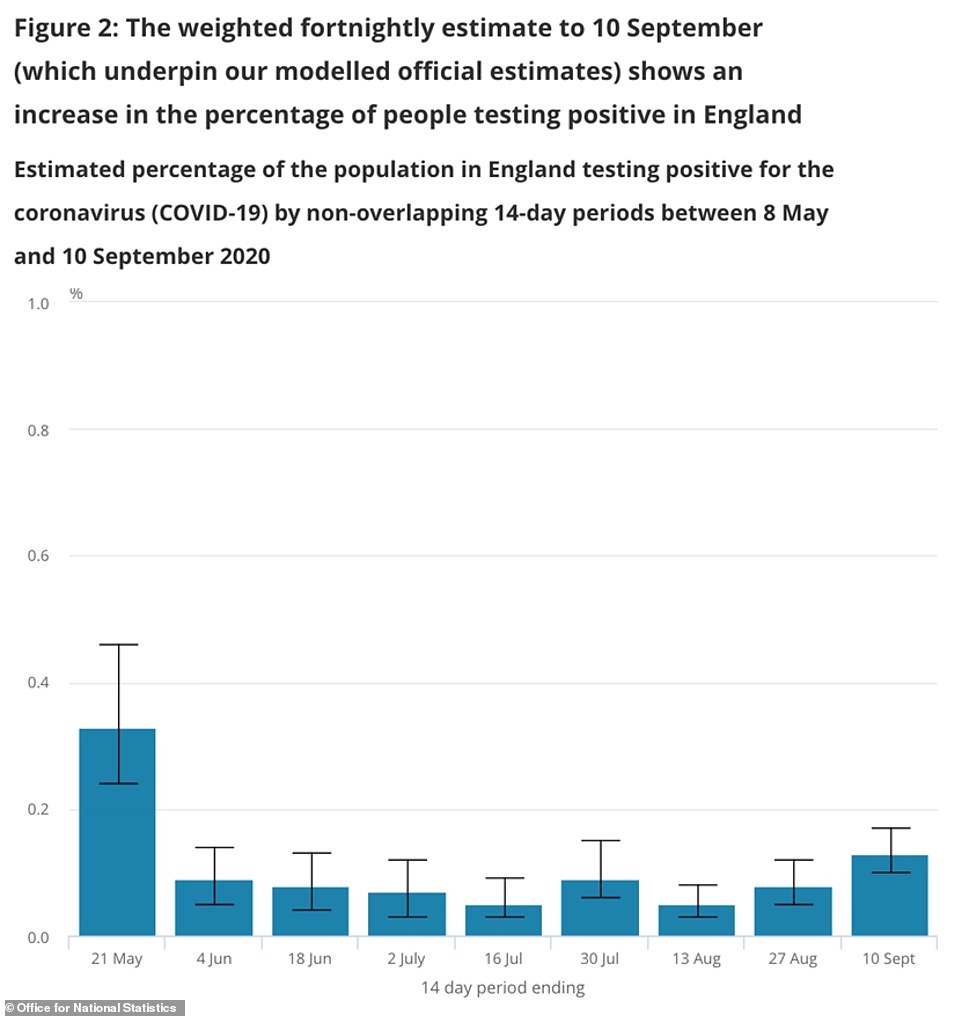
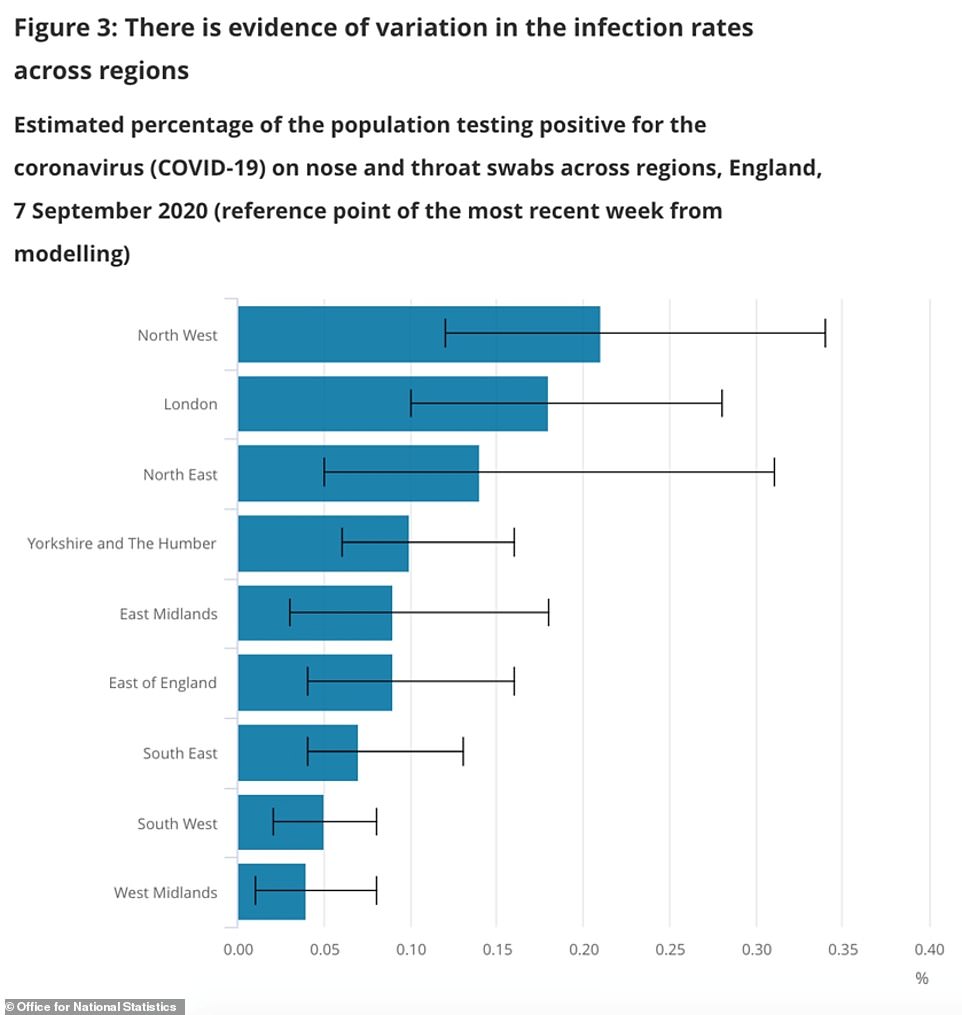
Government statistics show 194 newly-infected Covid-19 patients were admitted to hospitals in England on Tuesday, compared to just 84 eight days ago and just 38 on August 30. It means 154 patients are needing NHS care each day, on average — triple the figure of 52 on September 1.
More than 3,000 people each day were being admitted to NHS hospitals during the peak of the first wave in April. Analysis suggests, at the current trend, it would take little more than three weeks for daily admissions to top 2,000.
And a top infectious disease expert today warned that it is ‘plausible’ the doubling rate of every eight days could continue. Professor Paul Hunter, of University of East Anglia, told MailOnline the number of admissions could surpass the daily rate seen in March and April in just a month’s time.
Cases have spiked over the same time frame, with another 3,395 infections recorded yesterday — a 33 per cent rise in a week. Deaths are also starting to creep up, with the average number of patients dying each day now standing at 14 — up from seven a fortnight ago.
A weekly report by SAGE today said that the R rate for the UK appears to be between 1.2 and 1.4, while it is between 1.1 and 1.4 in England. These are the highest estimates the chief scientists have given since their regular updates began.
The R appears to be highest in the Midlands and North West, where it is thought to be between 1.2 and 1.5, meaning each infected case passes it on to 1.2 to 1.5 others, or every 10 infect 12 or 15 more.
If the R remains above 1 the outbreak will continue to grow and cases will keep surging, running the risk that local outbreaks spiral out of control into regional and even national problems.
SAGE cautions, however, that its estimates of R are around three weeks out of date each time they are published, because they are calculated by watching how the numbers of positive tests and hospital cases change over time.
More aggressive measures, including a national ‘circuit breaker’, are on the cards to stop the growth of the outbreak. The move could come as soon as next week, with pubs, restaurants and hotels facing being shut to prevent ‘significant’ casualties.
It comes as hospitals have been warned they must clear beds and brace themselves for a rise in coronavirus patients in the next few weeks.
MPs in London have been informed of plans to increase ‘step down’ beds in the capital, it was reported today. The beds will be made available to coronavirus patients who no longer need any hospital treatment, but can recover from the disease while isolating.
Hospitals cancelled thousands of surgeries like hip operations and cancer treatment to free up space for infected patients at the peak of the crisis, causing the NHS to have a record-high waiting list for routine treatment. The drive to free up beds in the first wave also saw coronavirus-infected patients discharged into care homes, where the virus was allowed to spread.
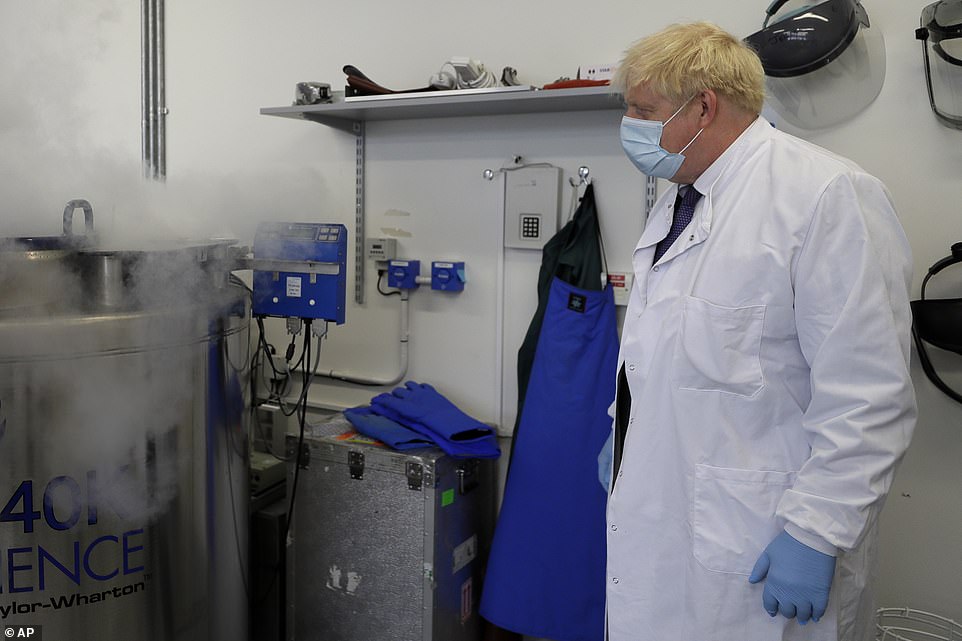
Prime Minister Boris Johnson visits the Jenner Institute in Oxford, England, today Friday, September 18
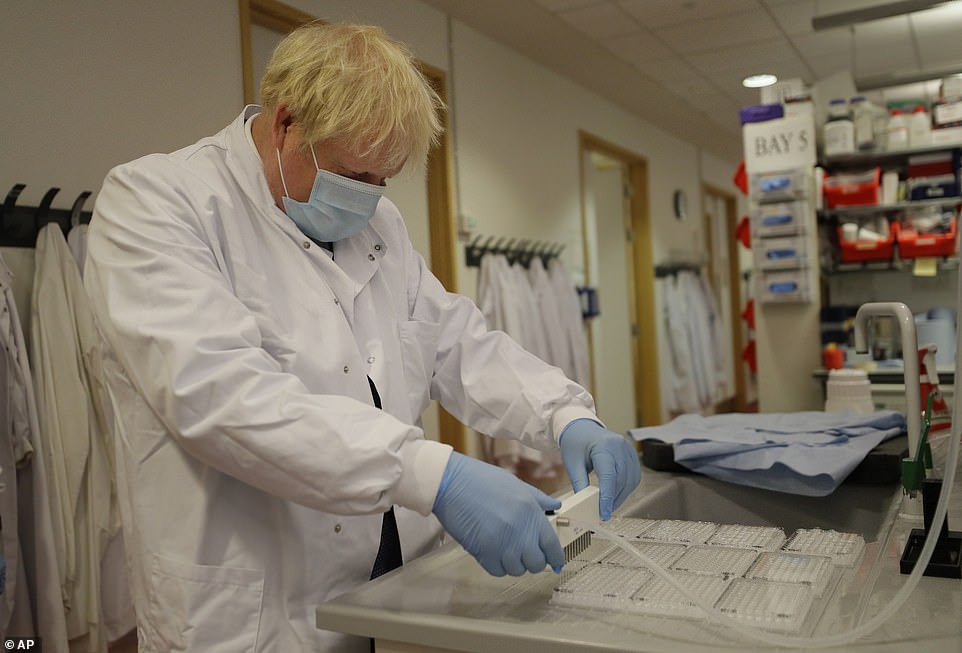
Boris Johnson is pictured during a visit to a testing lab in Oxford today. The Jenner Institute is the lab at the forefront of attempts to make a vaccine to prevent Covid-19
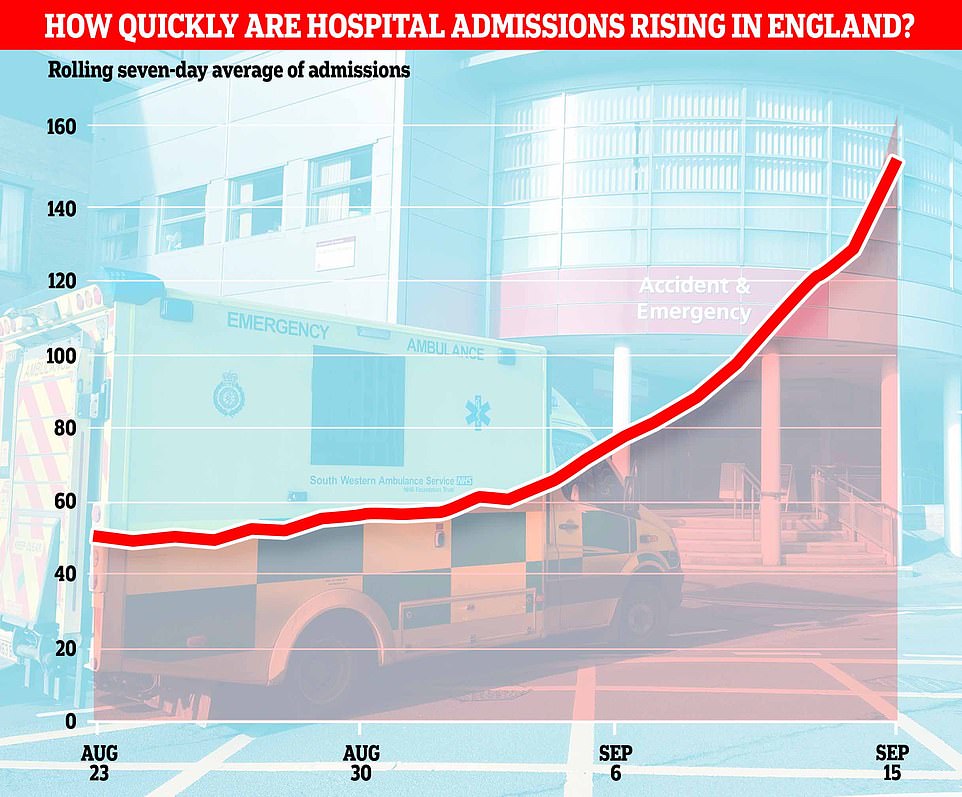
In an interview with BBC Breakfast this morning, Mr Hancock warned that it was ‘absolutely critical’ that people continued to follow the basic rules with regard to coronavirus.
He said: ‘We have seen an acceleration in the number of cases over the last couple of weeks and we’ve also sadly seen that the number of people hospitalised with coronavirus is doubling about every eight days, so we do need to take action.’
The government’s most-up-to-date data shows 194 Covid-19 patients in England were admitted to hospital on September 15 — at an average of 154 a day over the past week.
For comparison, the rolling seven-day average had dipped to as low as 45 on August 22, when just 25 hospital admissions were recorded across the country.
At the height of the pandemic at the start of April, the average number of daily admissions was 2,700. Britain’s lockdown and tough social distancing measures allowed the rate to plummet to below 1,000 by the start of May.
Department of Health chiefs say data is not updated every day by all four nations and the figures are not comparable. For instance, Wales include suspected Covid-19 patients while all the other nations include only confirmed cases.
Professor Hunter told MailOnline that the spike in admissions is ‘predictable’ and ‘expected’, given the spike in cases over the past few weeks.
He added: ‘It’s worrying that it’s going up but the big concern is how many hospital admissions we will end up seeing.
‘I suspect it will carry on… but I suspect we won’t see it doubling quite as rapidly because, often, these things start off quite fast and then they tail off after a little while.
‘It doesn’t always tail off, but ultimately it does because if it carries on doubling [at that speed], then soon every single person on the planet will be on hospital. So it has to tail off eventually.
‘The issue is when does it start tailing off? I have no way of knowing.’
Professor Hunter added that it was ‘plausible’ England’s hospital admissions could get up the levels seen in April but admitted he think it’s probably won’t happen.
He said: ‘The evidence is older people are still, sort of, social distancing themselves more than other groups, and they’re the group most likely to get hospitalised. There’s also a smaller pool to get infected and be hospitalised than we saw back in March and April.
‘But it may well continue, and it’s plausible that England could well in a month’s time be surpassing that figure. But I hope not.’
It comes as hospitals have been warned they must clear beds and brace themselves for a rise in coronavirus patients in the next few weeks. One MP who has seen the plans told the Telegraph: ‘I was told hospitals have reserved beds for people coming out of hospital who need somewhere to re-cover.
‘At the start of lockdown they were having to send people back to care homes or back to other facilities, with dire consequences, so they’ve booked places in respite care or empty care homes, so people will go out of hospital, but won’t return to their normal place of living.’
Another source said that councils have also been asked to find extra beds
It comes amid more testing chaos yesterday as Baroness Dido Harding, head of NHS Test and Trace, revealed that demand for coronavirus tests is currently up to four times greater than the system’s capacity.
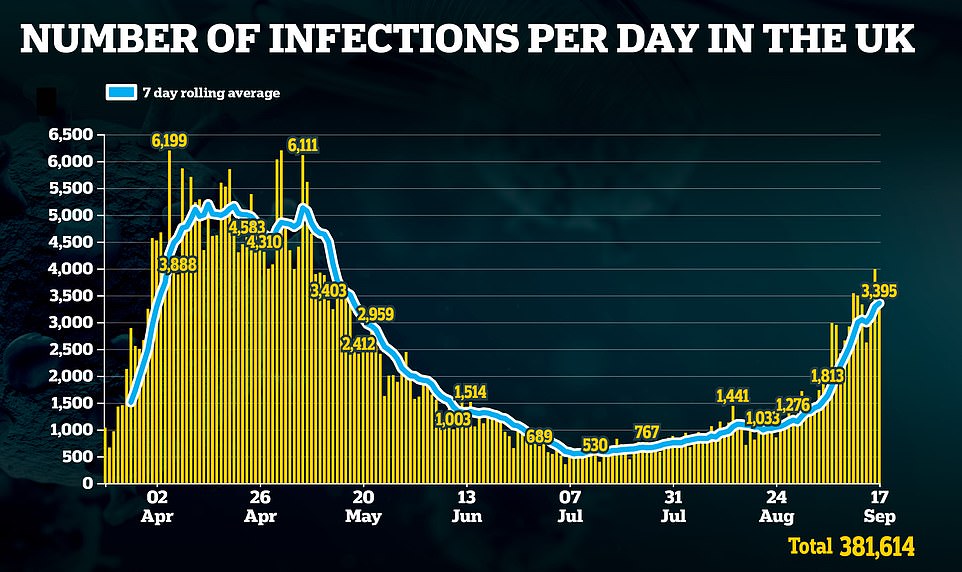
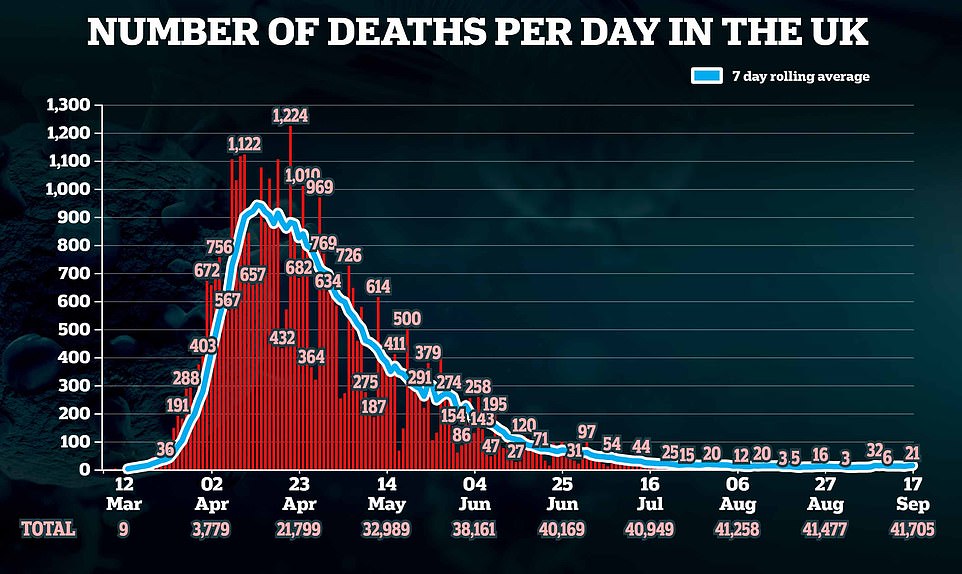
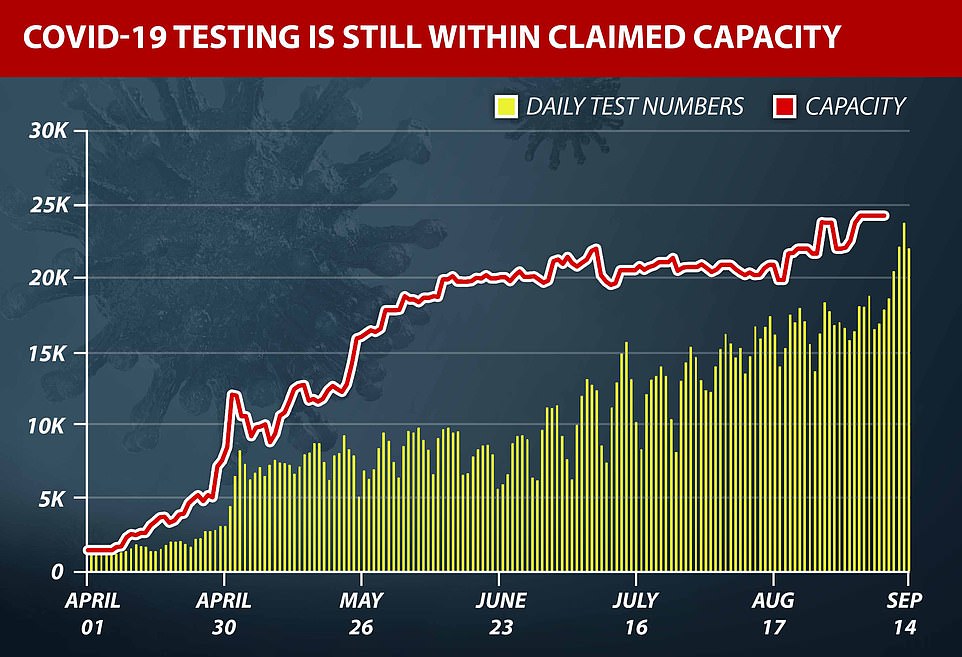
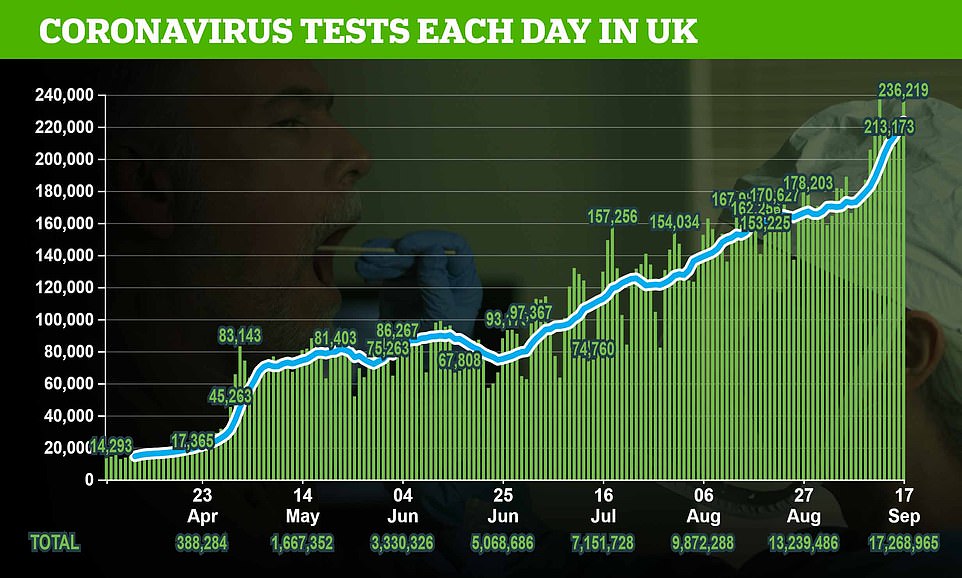
The government’s testing tzar also blamed the Government’s Scientific Advisory Group for Emergencies (SAGE) for seemingly getting its predictions wrong as she said testing capacity had been built based on the panel’s recommendations.
Last night it emerged the country’s faltering testing system could be outsourced to Amazon, as reported by The Telegraph.
A source said: ‘At the moment the man- agement of NHS Test and Trace has been in-house but as we go into winter we need experts in this area to take it forward.’
The government is also expected to announce tighter restrictions on care home visits in areas with high numbers of coronavirus cases are expected to be announced by the Government in its winter action plan.
Care homes in areas subject to local lockdowns may be advised to temporarily restrict visits in all but end-of-life situations, it is understood.
For parts of the country where there is no local lockdown, but where community transmission is a cause for concern, an option officials are considering is advising that visits are restricted to one designated visitor per resident.
The Government will set out further details on Friday in its social care action plan to help fight the spread of coronavirus over winter.
As part of the plan, care homes will receive free protective equipment and providers must stop ‘all but essential’ movement of staff between homes, the Department of Health and Social Care (DHSC) said.
This will be supported by an additional £546 million announced on Thursday as part of the extended infection control fund.
A new dashboard will monitor care home infections and help local government and providers respond quickly.
And a chief nurse for adult social care will be appointed to represent social care nurses and provide ‘clinical leadership’.
Local authorities and the Care Quality Commission will be asked to take ‘strong action’ in instances where providers are not restricting staff movement adequately.
The DHSC said this could include restricting a service’s operation and issuing warning notices.
Health and Social Care Secretary Matt Hancock said: ‘We are entering a critical phase in our fight against coronavirus with winter on the horizon.
‘Our priority over the next six months is to make sure we protect those most vulnerable receiving care and our incredibly hard-working workforce by limiting the spread of the virus and preventing a second spike.
‘This winter plan gives providers the certainty they need when it comes to PPE and provides additional support to help care homes to limit the movement of staff, stop the spread of coronavirus and save lives.
‘We will be monitoring the implementation of this carefully and will be swift in our actions to protect residents and colleagues across the country.’
It comes as Age UK said some older people are ‘dying of sadness’ because they have been cut off from loved ones over a long period of time.
Charity director Caroline Abrahams said it is important the plan achieves an ‘appropriate balance’ between ensuring infection control and allowing residents to keep in contact with loved ones.
She said: ‘All in all what we have seen so far is promising, but we will await with interest to read what the plan says about visiting in care homes.
‘With Covid-19 cases on the rise and winter on the way it’s right that every activity that could potentially place residents at risk is considered very carefully, including visiting, but any sense of a ‘blanket ban’ would be highly inappropriate, however anxious we may all feel.
‘Risks, capabilities and opportunities of all kinds differ hugely across care homes and for the sake of older people this enormous variation must be taken fully into account.’
Liz Kendall, Labour’s shadow social care minister, welcomed the appointment of a chief nurse and increased funding.
She continued: ‘But the real test of this plan is whether the Government delivers on weekly testing of all care staff – first promised in July but still not delivered, with serious concerns about delays in getting results back.
‘Ensuring families can visit their loved ones is also critical, as without this care home residents can end up fading fast.’
